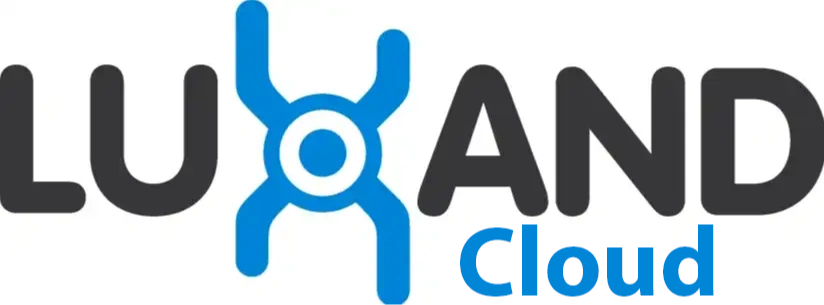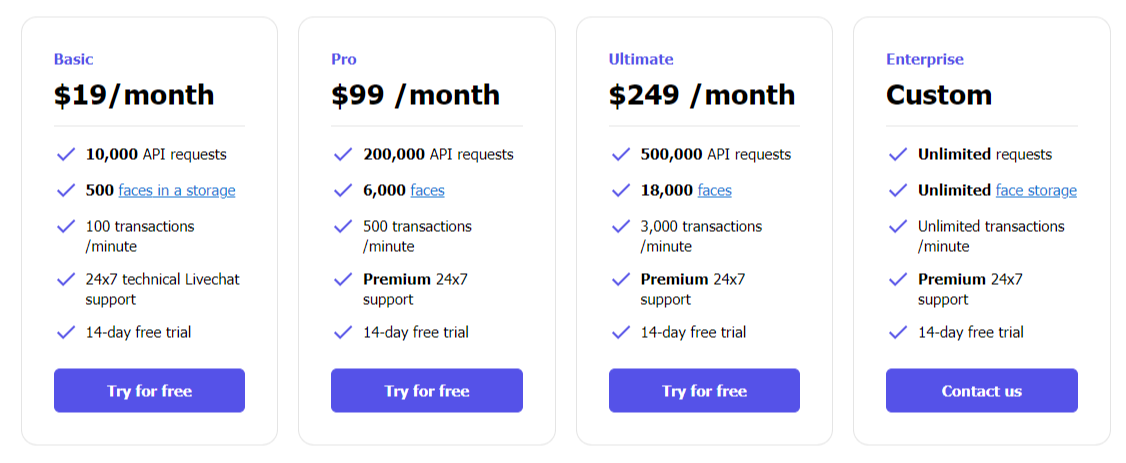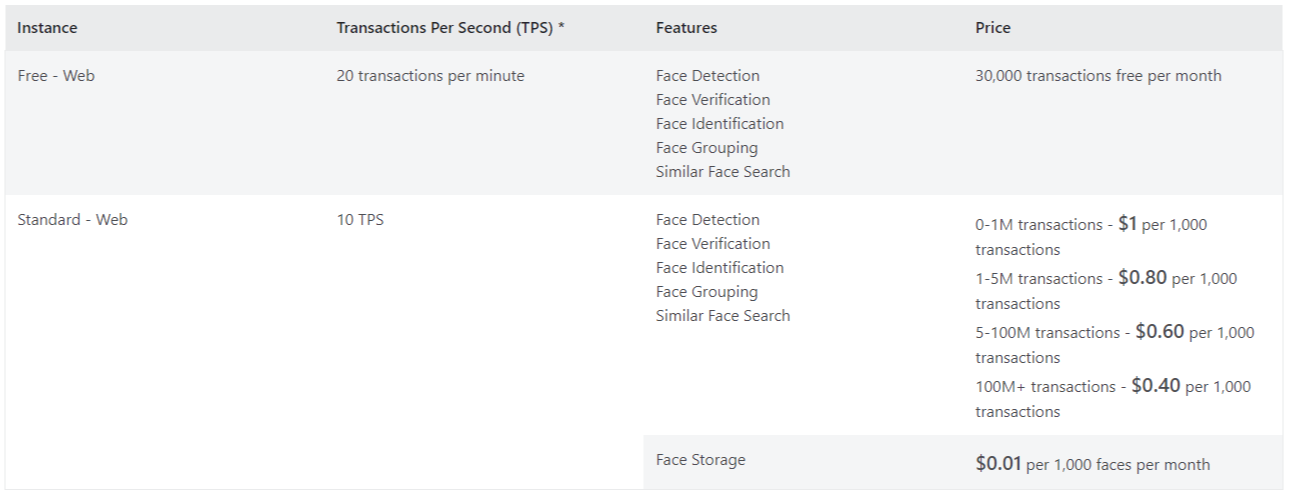
Face Recognition API: Luxand.cloud vs Microsoft Azure Face API
Face recognition is a way of identifying or confirming an individual’s identity using their face. Facial recognition systems can identify people in photos, videos, or in real time. Many people are familiar with face recognition technology through the FaceID used to unlock iPhones. Still, facial recognition is used in different industries and cases such as building access control, KYC, fraud prevention, attendance tracking, etc.
In this blog post, we want to provide you with a comparison between Microsoft Azure Face API and Luxand cloud since we understand how it is important to choose the right face recognition API for your project and business. We’ll compare prices, features, pluses, and minuses of both facial recognition APIs so you can choose wisely.
Luxand cloud
What is Luxand cloud
Luxand cloud is a versatile and powerful face recognition API that empowers developers to seamlessly integrate advanced facial recognition capabilities into their applications. It offers a comprehensive range of features, catering to a diverse range of use cases across various industries.
Luxand cloud Pricing
Luxand cloud offers a flexible pricing model that caters to diverse budgets and usage scenarios. It provides three main pricing plans: Basic, Pro, and Ultimate, each with varying features and pricing tiers.

Moreover, Luxand cloud offers a free trial for 14 days, so you can easily test it.
Luxand cloud Features
Luxand cloud is a cloud-based face recognition API that enables developers to integrate powerful facial recognition features into their applications. It offers a wide range of capabilities, including:
Face detection. Uncover faces within images and videos, even in challenging environments with varying lighting conditions, poor image quality, or occlusions.
Face recognition. Accurately identify and verify individuals across different images and videos, even after significant changes in appearance or expression.
Face verification. This feature helps to determine whether the two faces belong to the same person.
Emotion detection. You can integrate Luxand cloud emotion recognition API to detect people’s emotion since Luxand cloud is trained to recognize and analyze facial features such as the position of the eyebrows, shape of the mouth to identify and classify different emotions
Facial landmarks. Precisely extract facial landmarks, including the location of key facial features like eyes, nose, and mouth, enabling advanced analysis and manipulation.
Liveness detection. In order to prevent identity fraud, secure access control systems, and improve the accuracy of facial recognition technology, you can use the liveness detection API to verify that faces are real.
Face cropping. Face cropping API automatically detects and crops images with faces from larger photos. It can be useful to generate electronic user cards, for example.
Face similarity. This feature is used to compare two facial images to determine the degree of similarity between them. You get the result as a range from 0 to 100%, where a score of 100% means that the two faces are identical.
Pros
More affordable pricing for low-volume projects, particularly those with pre-existing face databases. Known for high accuracy and fast response times.
Offers a wider range of features, including emotion recognition, face analysis, liveness detection. But Microsoft Azure Face API doesn’t support emotion recognition.
Luxand cloud has consistently demonstrated high accuracy in face detection, recognition, and attribute detection, exceeding 99% in many cases.
Backed by a robust infrastructure and 24/7 support.
Luxand cloud takes security seriously and has implemented a number of security measures to protect its API and data. This makes it a secure choice for businesses that need to protect sensitive customer data.
Cons
While Luxand cloud is designed for high-volume usage, it lacks some of the advanced features that are typically required for enterprise-grade implementations. For example, it does not support multi-tenancy, role-based access control (RBAC), or audit logging.
Some users still may want more pricing plans.
Luxand cloud lacks advanced features such as morphing, blending, and texture transfer.
Summary
Luxand cloud stands out as a powerful and versatile face recognition API, providing developers with the tools to revolutionize their applications with cutting-edge facial recognition capabilities. Its comprehensive feature set, high accuracy, scalability, reliability, ease of integration, and cost-effectiveness make it an ideal choice for businesses seeking to enhance customer experiences, improve security, and unlock the power of facial recognition across various industries.
Microsoft Azure Face API
What is Microsoft Azure Face API?
The Microsoft Face API uses state-of-the-art cloud-based face algorithms. The main purpose of this API is to detect and recognize human faces in images. Generally speaking, this face recognition API supports face detection, face verification, and face grouping to organize faces into groups based on their visual similarity.
Microsoft Azure Face API Pricing
Azure Face API operates on a pay-as-you-go basis, eliminating hefty upfront costs. Transactions are priced per API call, with specific features carrying different rates.

Microsoft Azure Face API Features
Here are the Microsoft Azure Face API features:
Detection. The Microsoft Azure Face API allows developers to detect human faces in an image, return face rectangles, and optionally with faceIds, landmarks, and attributes. But they are retiring Face API attributes that predict emotion, gender, age, smile, facial hair, hair, and makeup, so you can’t use the emotion recognition feature.
Find Similar. This feature allows developers to search the similar-looking faces from a faceId array, a face list or a large face list. Find similar has two working modes, "matchPerson" and "matchFace". "matchPerson" is the default mode that tries to find faces of the same person. "matchFace" mode ignores same-person thresholds and returns ranked similar faces anyway, even the similarity is low.
Verification. You can verify whether two faces belong to the same person or whether one face belongs to a person.
Identification. The identification feature can find the closest matches of the specific query person face from a person group or large person group.
Group. Divide candidate faces into groups based on face similarity.
Pros
Offers a wider range of features, including emotion recognition, face analysis, and liveness detection.
Extensive feature set catering to diverse needs.
Global reach with deployment options in various regions.
Integrates seamlessly with other Azure services.
Cons
The Azure Face API pricing can lead to higher costs for high-volume projects.
Limited customization. Pre-built features offer flexibility, but may not cater to every niche need.
Privacy concerns due to Microsoft's data collection practices.
Lacking options like emotion recognition.
Summary
Microsoft Azure Face API is a powerful tool for developers and businesses, but choose wisely. Consider your budget and project needs before diving in. With careful planning, Azure Face API can unlock the fascinating world of facial recognition for your next project.
Conclusion
Both Luxand cloud and Microsoft Azure Face API are powerful and versatile face recognition APIs that offer a wide range of features and capabilities. However, they each have their own strengths and weaknesses that businesses should consider before making a decision. It all depends on your project, budget, and requirements.
However, we recommend you try Luxand cloud. It is a good choice for businesses that need a cost-effective and easy-to-use API with high accuracy and scalability. It is also a good option for businesses that need to integrate facial recognition into existing applications.